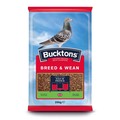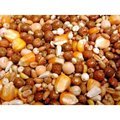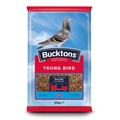When you think of these two birds, the images are very different. The dove is a serene, beautiful white bird, a symbol of love, peace and hope. The pigeon is a reviled bird often thought of as vermin, and its image is generally that of the blue/grey common wild pigeon seen all over the world.
The surprising thing to most people however is the close relationship of these seemingly two very different birds. In fact, doves and pigeons are the same thing.
There are more than 300 species of doves and pigeons and all are descended from the Rock Dove. Their taxonomic order is Columbiformes, there is only one family, Columbidae and they are defined by shared characteristics.
Characteristics of Columbidae
In appearance and behaviour, there is little difference between doves and pigeons.
Common characteristics are:
-
Short, rounded stout bodies with small, rounded heads
-
Small slim beaks with well-defined ceres (small fleshy patch)
-
Soft, dense feathers
-
Tapered wings
-
Short, scaly legs
-
Calls that have a cooing or crooning sound.
Within 300+ species, of course, there are going to be some variations. There are differences in size, the full spectrum of colours, different types of feathers and different vocalisations.
Characteristic behaviours are:
-
Regardless of habitat, all breeds build flimsy nests of twigs
-
Egg clutches are small, just one or two eggs
-
Care of eggs and raising chicks is undertaken by both parents, both producing crop milk
-
The same diet, being either
-
Granivorous - ground feeders that eat seeds and grains
-
Frugivorous – tree feeders that eat fruits and nuts
-
These characteristics are how biology defines pigeons and doves in order to decide on a species’ classification within the taxonomic system.
So, clearly, it’s scientifically established that doves and pigeons are the same thing, yet there persists the perception that there is a difference.
Why Are Doves and Pigeons Perceived to be Different?
Within 351 Columbidae species and multiple breeds within each species, there is bound to be a mass of variety. These variations can logically be grouped in six main areas:
-
Size
-
Appearance
-
Habitat
-
Diet
-
Calls
-
Predators
1. Size
From the smallest to the largest dove/pigeon, there is a huge margin.
The smallest member of the Columbidae family is the New World Ground Dove. Native to North America, this species weighs less than 40 g (1.5 oz) and is 15-18 cm (6-7 ins) in length.
The largest species is the Crowned Pigeon. Native to New Guinea, this species weighs between 2 and 4 kg (4 – 9 lbs) and measures up to 70 cm (28 ins) in length.
The average common pigeon weighs between 300 and 500 g (10 – 18 oz) and has a length of 32 - 37 cm (12 – 15 ins).
2. Appearance
Although the standard for all species is wings with 11 feathers, there is a huge diversity in plumage colour and markings, and also differences in feather structure as demonstrated by the frillback breeds. Some breeds have crests, like the elaborate Victorian Crowned Pigeon and others have feathered feet like the Ice Pigeon.
One of the more marked differences in physical appearance is that doves have bigger and more expressive tails than pigeons.
3. Habitat
One of the world’s most adaptable species, doves and pigeons have colonised every part of the Earth apart from the Sahara Desert, the High Arctic and Antarctica.
Habitat plays a part in defining appearance and behavioural characteristics and mostly by the range of the habitat. Some species have huge ranges such as the common pigeon which is known from the USA to China while others are endemic to a single island.
4. Diet
Habitat also plays a part in the Columbidae diet which has led to anatomical differences on whether the species is granivorous or frugivorous.
To process the hard casings of seeds and grains, evolution has provided the granivores with gizzards with thicker walls and longer intestines than the frugivores whose foods are softer. Frugivores have also evolved to be able to hang upside from branches to reach fruit, something not typical of granivorous doves and pigeons.
5. Calls
Both doves and pigeons make the cooing sound that is so predominantly associated with doves. In doves, it tends to be a softer call.
There is more diversity in the range of vocalisations of the pigeon species - some have become highly specialised. The Trumpeter Pigeon, for example, is so named because of its distinctive call.
6. Predators
All doves and pigeons are at the mercy of predators.
One of the greatest predators is man. Although pigeon is no longer a very common source of food, they are still killed for meat. Mostly however, and particularly in the USA, they are hunted for sport where more than 20 million doves are shot every year.
In the animal kingdom, the main predators of doves and pigeons are large carnivorous birds, mainly the falcons, hawks and eagles. Though most Columbiformes are excellent fliers, the birds of prey have stupendous dive velocities and easily outpace the much smaller doves and pigeons.
The doves and pigeons that spend a lot of time on the ground can fall prey to all manner of creatures, mammals and reptiles alike. The eggs of ground-nesting birds are the target of reptiles, snakes and rodents.
Now you know how doves and pigeons are the same but how they are different too. The interesting thing is that to the world, the image and symbolism of the white dove is instantly recognisable, but your view of a typical pigeon may be very different depending on where in the world you live.
Written by: Guest Author (Guest Author)








